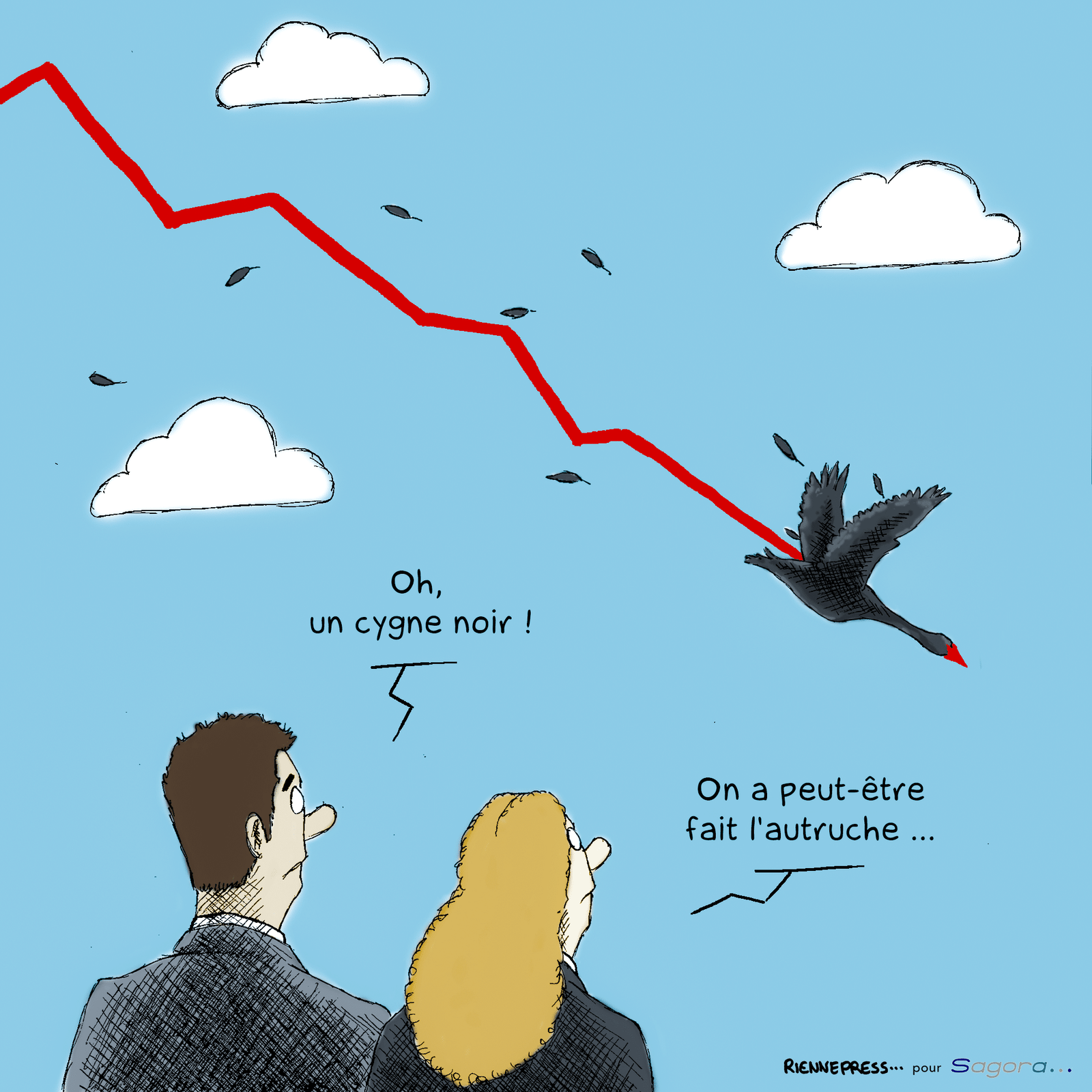
A Dive Into the Teachings of Nassim Taleb
Black swans, a term by now well known in the financial world to describe events that are unpredictable, consequential but in retrospect inevitable, are nothing new. Yet 'Black Swans', as they are often called, remain eternally misunderstood, and are both an investor's El Dorado and worst nightmare.
Yes, as majestic as they may appear, swans do bite, or at least... peck. So it's important to learn how to tame them if you want to enjoy the spectacle of their ballet without being dragged to the bottom of the lake like Lehman Brothers and many others.
In this article, we will delve into the teachings of Nassim Nicholas Taleb to gain a better understanding of these Black Swans and the consequences of the infamous Lehman Brothers case. But first, let's take a step back in time to understand the origins of this concept.
The Origins of the Black Swan
Coined by the Latin poet Juvenal, the expression "black swans" was first used in his poem Satire VI. In it, he compares the rarity of the ideal woman, with her many qualities, to that of a bird with black plumage. Behind this smile-inducing analogy lies a far more alarming observation: the fragility of the human thought system.
At that time, the black swan was seen as a chimera, an impossible event, even in the most fertile imagination. And yet, in 1697, the Dutch explorer Willem discovered one in the still unknown land of Australia, challenging the hitherto unshakeable European view that a swan could only be white. The black swan theory shows us that a single event, a single occurrence, can be enough to demolish hypotheses and logical constructs built up over time. "Just because we've never seen a black swan doesn't mean it doesn't exist". An excuse to be used advisedly, of course.
The Teachings of Nassim Taleb

Nassim Nicholas Taleb, an eminent economics professor and writer, is credited with bringing the concept of the Black Swan to the financial markets, to denounce the undervaluation of rare events in terms of both occurrence and price.
In his book "Le cygne noir : la puissance de l'imprévisible" ("The Black Swan: the Impact of the Highly Improbable"), he explains the existence of unpredictable low-probability events, known as black swans, which, if they occur, have considerable repercussions. In this article, we look at three key aspects of his theory: the discord between Gauss and the Black Swans, the imperfections of the human brain, and the possibility of taming unpredictable phenomena.
Beware the Gaussian Curve
The reputation of this star of statistics is well established. With its iconic bell curve, the Gaussian describes the symmetrical distribution of data around the mean. The idea is simple: the closer an observation is to the mean, the greater the probability that it will occur. Conversely, the further away it is from the tails of the curve, the rarer the observation will be.
With all due respect to the Gaussian model, which has proved useful in many situations, if we were to listen to it when predicting extreme events, the stock market crash of October 1987 would only occur once every 10 years.17 Yet extreme events of recent years include: the 1929 crash, the bursting of the internet bubble in 2000, the attacks of 11 September 2001, the global financial crisis of 2007-2008, the Fukushima nuclear disaster in 2011, the COVID-19 pandemic, etc.
The Gaussian Curve and Stock Markets
Another way of illustrating the limitations of the Gauss model is to look at the daily returns of the Dow Jones index from 1928 to 2009. Normal distribution tells us that extreme events, defined here as daily returns of more than 6%, should only occur one day in a million. In reality, we're closer to 2,500 days in a million, i.e. not far from one day a year. So, unless we use different calendars, these events occur much more frequently than the bell curve suggests.
Relying on the Gaussian curve means wrongly assuming that extreme events are rare. In the context of the stock market, this can have devastating consequences, as shown by the numerous systemic crises.
The Example of Lehman Brothers
Take Lehman Brothers, for example. The collapse of this American bank in 2008 completely escaped the radar of many investors. And yet a number of warning lights were on: excessive exposure to the US mortgage markets, financial products that spread risk around the world, a business strategy based on high leverage with low levels of capital, and so on. Carried away by widespread optimism, investors and regulators ignored these indicators and paid the price.
Human Laziness in the Face of Black Swans
The human mind also has its share of flaws, and this is nothing new. Lazy by nature, our brain uses many shortcuts, making it vulnerable to cognitive biases. We have an aversion to uncertainty, and so we look for explanations for all phenomena, trying to confirm them by any means possible.
The Black Swan cognitive bias is simply an optical illusion that plays tricks on our brains. We interpret visual information on the basis of past experience, and fill in the gaps by relying on pre-existing patterns. And yet, what a surprise when the picture finally comes into focus and reveals itself to us! So... keep your eyes peeled!
Learning to Tame Black Swans
We can't escape the improbable. Unfortunately, we have no control over the black swans chasing us around the lake. But fortunately, we have brains and two arms and two legs that we can control, so that we can, for example, throw a piece of bread at an enraged bird, or jump behind a fence to protect ourselves. Extreme events have always existed and will continue to exist, so we might as well learn to tame them.
Diversifying Your Assets: One Way of Limiting Damage Brought by Extreme Events
As an investor, the asset diversification of your portfolio is a good example of a Black Swan adjustment strategy. As the saying goes, "don't put all your eggs in one basket". If the Black Swans eventually catch up with us, we might as well be able to show them that the eggs we're holding don't all come from their nest, but also from that of the neighbour's hen, the swallow in the orchard, and so on, so as to save ourselves a lot of grief.
Time Diversification: An Essential Strategy
In addition to asset diversification, temporal diversification is also essential to cope with extreme events. This means spreading your investment over a given period, rather than betting everything at a given time.
By spreading your investment over time, you reduce the risk associated with market timing. Let's say you have a tidy sum of 60,000 euros to invest. Instead of investing the whole amount today, you decide to allocate 5,000 euros a month over a period of one year. This way, if an extreme event occurs after just two months, you will only suffer losses on part of your investment, i.e. 10,000 euros.
Time diversification thus allows you to mitigate the potential impact of extreme events on your portfolio. Simply by spreading your investments strategically over time.
Conclusion: How Do You Tame Black Swans to Succeed on the Financial Markets?
Black Swans are not an inherent inevitability. Rather, they represent an opportunity to test our resilience in the face of adversity and sometimes even to take advantage of serendipity. Indeed, so far we've only looked at their negative aspects but these can also have positive repercussions. It is therefore essential to understand how to take advantage of them while guarding against negative events.
To achieve this, Taleb offers a series of valuable tips:
- Keep an eye out for unexpected events.
- Adopt a flexible attitude in your beliefs and thinking.
- Challenge your assumptions and look beyond the obvious.
In short, place yourself in situations where the positive consequences are far more important than the negative ones.
But most important of all: recognise the limits of knowledge and constantly challenge received wisdom. That's precisely the approach we'll be pursuing in our weekly articles!
Key Points to Remember When It Comes to Black Swans According to Nassim Taleb
- Black swans are unpredictable, low-probability events. Their repercussions are considerable but, in retrospect, they seem inevitable.
- Extreme events are not rare, and the Gaussian curve is not a good tool for measuring them.
- The human thought system is fragile and subject to many biases.
- We cannot control extreme events. But we can control how we react to them, both through asset and time diversification. As an investor, you have many tools at your disposal to adjust to Black Swans.
- It is possible to take advantage of positive Black Swans. Keep your eyes open, remain flexible and embrace these opportunities.
Would you like to effortlessly navigate the turbulent waters of the financial markets? Visit our website to find out more about our training programme in portfolio management !
#FinancialTraining #PortfolioManagement #PersonalFinance #Diversification #KnokkeSummerSchool
Portfolio Management
Our portfolio management courses are offered at different locations and on different dates.
- 20, 22 and 24 August in Knokke
- 19, 21 and 23 August in Knokke
- 28 and 29 November in Brussels
Sources
- Juvenal, Satire VI, translation by V. Raoul (1812). https://remacle.org/bloodwolf/satire/juvenal/satire6a.htm
- Raikar, S. P. (2023, February 3). Black swan event | Definition, History, Examples, & Facts. Encyclopedia Britannica. https://www.britannica.com/topic/black-swan-event
- Schmit, M. (2023). Banking and Asset Management. Understanding Banking Performance [Slides].
- Wiggins, R. Z., Piontek, T., & Metrick, A. (2014). The Lehman Brothers Bankruptcy A: Overview. Social Science Research Network. https://doi.org/10.2139/ssrn.2588531

